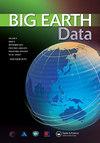A long-term daily gridded snow depth dataset for the Northern Hemisphere from 1980 to 2019 based on machine learning
IF 3.8
3区 地球科学
Q1 COMPUTER SCIENCE, INFORMATION SYSTEMS
引用次数: 1
Abstract
. A h igh-quality snow depth product is very import for cryospheric science and its related disciplines. Current long time-series snow depth products covering the Northern Hemisphere can be divided into two categories: remote sensing snow depth product and reanalysis snow depth products. However, existing gridded snow depth products have some shortcomings. Remote sensing-derived snow depth products are temporally and spatially discontinuous and tend to underestimate snow depth, while reanalysis snow depth products have coarse spatial resolutions and great uncertainties. To overcome these 20 problems, in our previous work we proposed a novel data fusion framework based on Random Forest Regression of snow products from Advanced Microwave Scanning Radiometer for the Earth Observing System (AMSR-E), Advanced Microwave Scanning Radiometer 2 (AMSR-2), Global Snow Monitoring for Climate Research (GlobSnow), the Northern Hemisphere Snow Depth (NHSD), ERA-Interim, and Modern-Era Retrospective Analysis for Research and Applications, version 2 (MERRA-2), incorporated geolocation (latitude and longitude), and topographic data (elevation), which were used 25 as input independent variables. More than 30,000 ground observation sites were used as the dependent variable to train and validate the model in different time period. This fusion framework resulted in a long time series of continuous daily snow depth product over the Northern Hemisphere with a spatial resolution of 0.25°. Here we compared the fused snow depth and the original gridded snow depth products with 13,272 observation sites, showing an improved precision of our product. The evaluation indexes of the fused (best original) dataset yielded a coefficient of determination R 2 of 0.81 (0.23), Root Mean 30 Squared Error (RMSE) of 7.69 (15.86) cm, and Mean Absolute Error (MAE) of 2.74 (6.14) cm. Most of the bias (88.31%) between the fused snow depth and in situ observations was distributed from -5 cm to 5 cm depths. The accuracy assessment of independent snow observation sites – Sodankylä (SOD), Old Aspen (OAS), Old Black Spruce (OBS), and Old Jack Pine (OJP) – showed that the fused snow depth dataset had high precision under snow depths of less than 100 cm with a relatively homogeneous surrounding environment. In the altitude range of 100 m to 2000 m, the fused snow depth had a higher 35 precision, with R 2 varying from 0.73 to 0.86. The fused snow depth had a decreasing trend based on the spatiotemporal analysis and Mann-Kendall trend test method. This fused snow depth product provides the basis for understanding the temporal and spatial characteristics of snow cover and their relation to climate change, hydrological and water cycle, water resource management, ecological environment and snow disaster and hazard prevention. The new fused snow depth dataset is freely available from the National Plateau Data Center (TPDC) and can be downloaded at 40 https://dx.doi.org/10.11888/Snow.tpdc.271701 (Che et al., 2021). This snow depth also can be downloaded at https://zenodo.org/record/6336866#.Yjs0CMjjwzY. gridded datasets cross-validation fused snow depth dataset. snow pixel is complex, with grass, bare rock and forest. In a 0.25° pixel, this site only represents a small region; the elevation range was varied from 2700 m to 3900 m. These two sites can be used to observe the snowpack characteristics in a basin but can not represent the large area snow depth. The WFJ site is located on a hillside at an altitude of about 2540 m. The major landcover type is grassland in one pixel, but this site has a higher altitude. The elevation increased from 800 to 2600 m over 350 one pixel, so this site also has a complex environment. During the winter months, deeper snow builds up at this altitude. These results indicate that the accuracy of the fused snow depth dataset was heavily dependent on the input gridded snow depth products. Additionally, the snow depths changed too rapidly to be accurately captured by these products. In other words, the fused snow depth dataset had higher accuracy at the snow depths of less than 100 cm. Plateau had snow depth of about 5 to 10 cm. There were fewer in situ observations to train the random forest 410 data fusion framework, resulting in a lower snow depth accuracy in this region.基于机器学习的1980 - 2019年北半球长期日网格化雪深数据集
. 高质量的雪深产品对冰冻圈科学及其相关学科非常重要。目前覆盖北半球的长时间序列雪深产品可分为两类:遥感雪深产品和再分析雪深产品。然而,现有的网格化雪深产品存在一些不足。遥感雪深产品在时间和空间上不连续,容易低估雪深,而再分析雪深产品空间分辨率较粗,不确定性较大。为了解决这20个问题,我们在之前的工作中提出了一种新的数据融合框架,该框架基于对地观测系统高级微波扫描辐射计(AMSR-E)、高级微波扫描辐射计2 (AMSR-2)、全球气候监测(GlobSnow)、北半球雪深(NHSD)、ERA-Interim和现代研究与应用回顾性分析第2版(MERRA-2)雪产品的随机森林回归。结合地理位置(纬度和经度)和地形数据(海拔),它们被用作输入自变量。以3万多个地面观测点作为因变量,在不同时间段对模型进行训练和验证。这种融合框架产生了北半球连续日雪深产品的长时间序列,空间分辨率为0.25°。通过对13272个观测站点的融合雪深和原始网格化雪深产品进行比较,我们的产品精度得到了提高。融合(最佳原始)数据集的评价指标的决定系数r2为0.81(0.23),均方根误差(RMSE)为7.69 (15.86)cm,平均绝对误差(MAE)为2.74 (6.14)cm。融雪深度与原位观测偏差最大(88.31%)分布在-5 ~ 5 cm深度。通过对Sodankylä (SOD)、Old Aspen (OAS)、Old Black Spruce (OBS)和Old Jack Pine (OJP)独立积雪观测点的精度评估,结果表明,在雪深小于100 cm、周围环境相对均匀的情况下,融合雪深数据具有较高的精度。在海拔100 ~ 2000 m范围内,融合雪深具有较高的35精度,r2在0.73 ~ 0.86之间变化。基于时空分析和Mann-Kendall趋势检验方法,融合雪深呈减小趋势。该融合雪深产品为了解积雪时空特征及其与气候变化、水循环、水资源管理、生态环境和雪灾防灾的关系提供了基础。新的融合雪深数据集可从国家高原数据中心(TPDC)免费获得,可在40 https://dx.doi.org/10.11888/Snow.tpdc.271701下载(Che et al., 2021)。积雪深度也可以在https://zenodo.org/record/6336866#.Yjs0CMjjwzY下载。网格数据集交叉验证融合雪深数据集。雪像素是复杂的,有草,光秃秃的岩石和森林。在0.25°像素中,该位点仅代表一个小区域;海拔范围从2700米到3900米。这两个站点可以用来观测一个流域的积雪特征,但不能代表大面积的雪深。WFJ基地位于海拔约2540米的山坡上。在一个像素上,主要的土地覆盖类型是草地,但这个站点海拔更高。海拔从800米上升到2600米,超过350个像素,所以这个场地也有一个复杂的环境。在冬季的几个月里,在这个海拔高度,积雪堆积得更深。这些结果表明,融合雪深数据集的精度严重依赖于输入的网格化雪深产品。此外,雪深变化太快,这些产品无法准确捕获。也就是说,融合的雪深数据集在小于100 cm的雪深下具有更高的精度。高原积雪深度约为5至10厘米。随机森林410数据融合框架的现场观测数据较少,导致该地区雪深精度较低。
本文章由计算机程序翻译,如有差异,请以英文原文为准。
求助全文
约1分钟内获得全文
求助全文
来源期刊

Big Earth Data
Earth and Planetary Sciences-Computers in Earth Sciences
CiteScore
7.40
自引率
10.00%
发文量
60
审稿时长
10 weeks
 求助内容:
求助内容: 应助结果提醒方式:
应助结果提醒方式:


